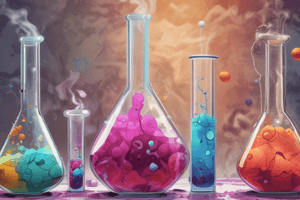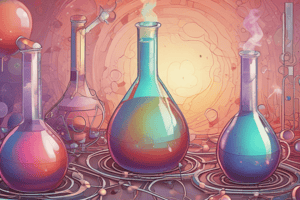Podcast
Questions and Answers
What type of reaction is 2CH4 + 3O2 → 2CO2 + 3H2O?
What type of reaction is 2CH4 + 3O2 → 2CO2 + 3H2O?
- Combustion Reaction (correct)
- Decomposition Reaction
- Neutralization Reaction
- Single Displacement Reaction
What is the first step in balancing a chemical equation?
What is the first step in balancing a chemical equation?
- Add coefficients to balance the equation.
- Write the unbalanced equation with the reactants on the left and products on the right. (correct)
- Check the equation to ensure it is balanced.
- Count the number of atoms of each element on both sides of the equation.
What is an example of a Double Displacement Reaction?
What is an example of a Double Displacement Reaction?
- 2H2 + O2 → 2H2O
- HCl + NaOH → NaCl + H2O
- Zn + CuSO4 → ZnSO4 + Cu (correct)
- 2CH4 + 3O2 → 2CO2 + 3H2O
What is the statement of the Law of Conservation of Mass?
What is the statement of the Law of Conservation of Mass?
What is the term for the change in concentration of reactants or products per unit time?
What is the term for the change in concentration of reactants or products per unit time?
What should be done last when balancing a chemical equation?
What should be done last when balancing a chemical equation?
What is a factor that affects reaction rates?
What is a factor that affects reaction rates?
What is the mathematical representation of the Law of Conservation of Mass?
What is the mathematical representation of the Law of Conservation of Mass?
What type of reaction is NaCl + AgNO3 → NaNO3 + AgCl?
What type of reaction is NaCl + AgNO3 → NaNO3 + AgCl?
Why should you use the smallest whole number coefficients possible when balancing an equation?
Why should you use the smallest whole number coefficients possible when balancing an equation?
Flashcards are hidden until you start studying
Study Notes
Types of Chemical Reactions
- Synthesis Reaction: Two or more substances combine to form a new compound.
- Example: 2H2 + O2 → 2H2O
- Decomposition Reaction: A single compound breaks down into two or more substances.
- Example: 2H2O → 2H2 + O2
- Single Displacement Reaction: One element displaces another element from a compound.
- Example: Zn + CuSO4 → ZnSO4 + Cu
- Double Displacement Reaction: Two compounds exchange partners, resulting in the formation of two new compounds.
- Example: NaCl + AgNO3 → NaNO3 + AgCl
- Combustion Reaction: A substance reacts with oxygen to produce heat and light.
- Example: 2CH4 + 3O2 → 2CO2 + 3H2O
- Neutralization Reaction: An acid reacts with a base to form a salt and water.
- Example: HCl + NaOH → NaCl + H2O
Chemical Equation Balancing
- Steps to balance an equation:
- Write the unbalanced equation with the reactants on the left and products on the right.
- Count the number of atoms of each element on both sides of the equation.
- Add coefficients (numbers in front of formulas of reactants or products) to balance the equation.
- Check the equation to ensure it is balanced.
- Tips for balancing:
- Start with elements that appear in only one formula on each side of the equation.
- Balance elements that are combined in a single formula last.
- Use the smallest whole number coefficients possible.
Law of Conservation of Mass
- Statement: Matter cannot be created or destroyed in a chemical reaction.
- Implication: The total mass of reactants equals the total mass of products.
- Mathematical representation: ∑(mass of reactants) = ∑(mass of products)
Chemical Reaction Rates
- Factors affecting reaction rates:
- Concentration of reactants
- Temperature
- Surface area of reactants
- Presence of catalysts
- Rate of reaction: The change in concentration of reactants or products per unit time.
- Units: moles per liter per second (mol/L·s) or molecules per second (molecules/s)
Stoichiometry
- Definition: The study of the quantitative relationships between reactants and products in a chemical reaction.
- Mole ratios: The ratio of moles of reactants to moles of products.
- Limiting reagent: The reactant that is consumed first, limiting the amount of product formed.
- Excess reagent: The reactant that is present in excess, not limiting the amount of product formed.
- Percent yield: The ratio of actual yield to theoretical yield, expressed as a percentage.
Types of Chemical Reactions
- Synthesis Reaction: Two or more substances combine to form a new compound, for example, 2H2 + O2 → 2H2O.
- Decomposition Reaction: A single compound breaks down into two or more substances, for example, 2H2O → 2H2 + O2.
- Single Displacement Reaction: One element displaces another element from a compound, for example, Zn + CuSO4 → ZnSO4 + Cu.
- Double Displacement Reaction: Two compounds exchange partners, resulting in the formation of two new compounds, for example, NaCl + AgNO3 → NaNO3 + AgCl.
- Combustion Reaction: A substance reacts with oxygen to produce heat and light, for example, 2CH4 + 3O2 → 2CO2 + 3H2O.
- Neutralization Reaction: An acid reacts with a base to form a salt and water, for example, HCl + NaOH → NaCl + H2O.
Chemical Equation Balancing
- Steps to balance an equation: Write the unbalanced equation, count the number of atoms of each element, add coefficients, and check the equation to ensure it is balanced.
- Tips for balancing: Start with elements that appear in only one formula, balance elements that are combined in a single formula last, and use the smallest whole number coefficients possible.
Law of Conservation of Mass
- Statement: Matter cannot be created or destroyed in a chemical reaction.
- Implication: The total mass of reactants equals the total mass of products.
- Mathematical representation: ∑(mass of reactants) = ∑(mass of products).
Chemical Reaction Rates
- Factors affecting reaction rates: Concentration of reactants, temperature, surface area of reactants, and presence of catalysts.
- Rate of reaction: The change in concentration of reactants or products per unit time.
- Units: moles per liter per second (mol/L·s) or molecules per second (molecules/s).
Stoichiometry
- Definition: The study of the quantitative relationships between reactants and products in a chemical reaction.
- Mole ratios: The ratio of moles of reactants to moles of products.
- Limiting reagent: The reactant that is consumed first, limiting the amount of product formed.
- Excess reagent: The reactant that is present in excess, not limiting the amount of product formed.
- Percent yield: The ratio of actual yield to theoretical yield, expressed as a percentage.
Studying That Suits You
Use AI to generate personalized quizzes and flashcards to suit your learning preferences.




